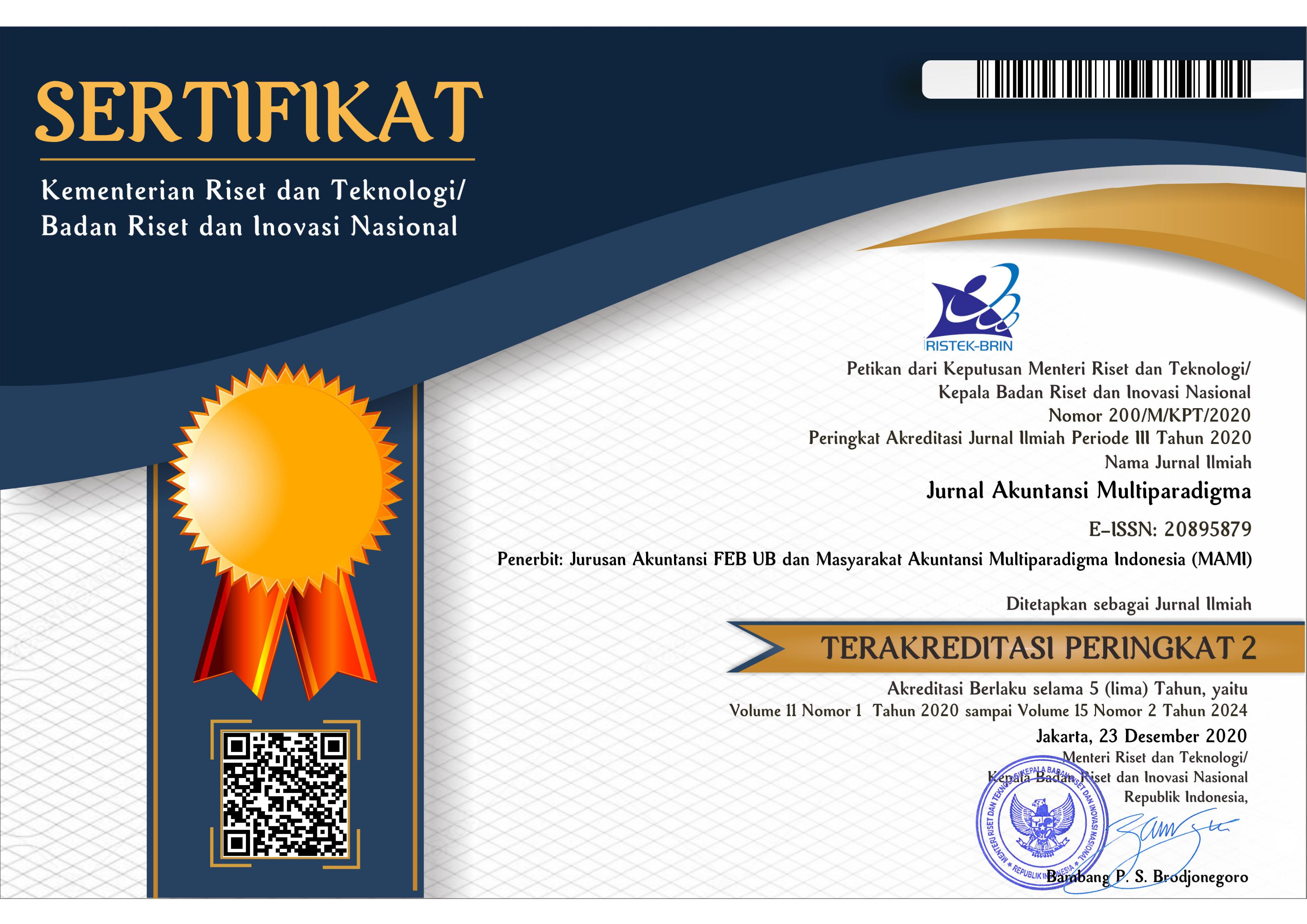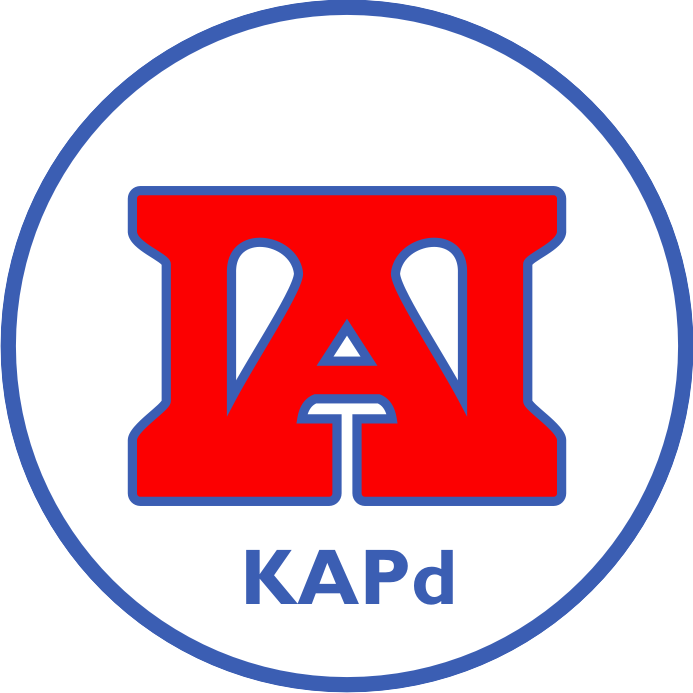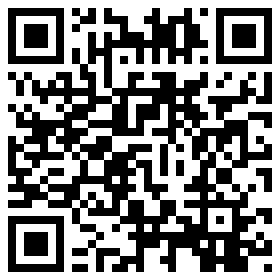IS COST STICKINESS A BAD SIGNAL FROM CATUR MARGA PERSPECTIVE?
Abstract
Abstrak: Apakah Cost Stickiness merupakan Sinyal Buruk dari Perspektif Catur Marga? Penelitian ini berupaya untuk mengupas determinan asimetri perilaku biaya dari perspektif Hindu Weda, yaitu catur marga. Kajian literatur digunakan sebagai metode. Penelitian ini menyimpulkan bahwa ketika mengambil keputusan, manajer mempertimbangkan belas kasih (bhakti marga), pengetahuan yang dimiliki (jnana marga), upaya untuk berbuat baik (karma marga), dan pengendalian diri atas kepentingan pribadi (raja marga). Perilaku biaya sangat dipengaruhi oleh kebijakan yang dibuat oleh manajer. Kebijakan tersebut terkait dengan pengelolaan sumber dayanya, terutama ketika menghadapi permintaan yang menurun.
Abstract: Is Cost Stickiness a Bad Signal from Catur Marga Perspective? This research seeks to explore the determinants of the asymmetry of cost behaviour from a Veda Hindu perspective, namely catur marga. The method used is the literature review. This paper suggests that when making decisions, managers considered compassion (bhakti marga), the knowledge they possess (jnana marga), the effort to do good deeds (karma marga), and self-control over their own personal interest (raja marga). Cost behaviour is strongly influenced by the policy made by the manager in relation to his/her resources’ management, especially when confronted with declining demand.
Keywords
Full Text:
PDFReferences
Ahmed, A., Arshad, M. A., Mahmood, A., & Akhtar, S. (2019). The Influence of Spiritual Values on Employee’s Helping Behaviour: The Moderating Role of Islamic Work Ethic. Journal of Management, Spirituality and Religion, 16(3), 235–263. https://doi.org/10.1080/14766086.2019.1572529
Anderson, M., Asdemir, O., & Tripathy, A. (2013). Use of Precedent and Antecedent Information in Strategic Cost Management. Journal of Business Research, 66(5), 643–650. https://doi.org/10.1016/j.jbusres.2012.08.021
Anderson, M. C., Banker, R. D., & Janakiraman, S. N. (2003). Are Selling, General, and Administrative Costs “Sticky”? Journal of Accounting Research, 41(1), 47–63. https://doi.org/10.1111/1475-679X.00095
Argilés-Bosch, J. M., García-blandón, J., Ravenda, D., Valencia-Silva, M. M., & Somoza, A. D. (2017). The Influence of the Trade-Off between Profitability and Future Increases in Sales on Cost Stickiness. Estudios de Economia, 44(1), 81–104.
Balakrishnan, R., Labro, E., & Soderstrom, N. S. (2014). Cost Structure and Sticky Costs. Journal of Management Accounting Research, 26(2), 91–116. https://doi.org/10.2308/jmar-50831
Balog, A. M., Baker, L. T., & Walker, A. G. (2014). Religiosity and Spirituality in Entrepreneurship: A Review and Research Agenda. Journal of Management, Spirituality and Religion, 11(2), 159–186. https://doi.org/10.1080/14766086.2013.836127
Banker, R. D., Byzalov, D., Ciftci, M., & Mashruwala, R. (2014). The Moderating Effect of Prior Sales Changes on Asymmetric Cost Behaviour. Journal of Management Accounting Research, 26(2), 221–242. https://doi.org/10.2308/jmar-50726
Banker, R. D., & Byzalov, D. (2014). Asymmetric Cost Behaviour. Journal of Management Accounting Research, 26(2), 43–79. https://doi.org/10.2308/jmar-50846
Banker, R. D., Byzalov, D., & Chen, L. T. (2013). Employment Protection Legislation, Adjustment Costs and Cross-Country Differences in Cost Behaviour. Journal of Accounting and Economics, 55(1), 111–127. https://doi.org/10.1016/j.jacceco.2012.08.003
Banker, R. D., Byzalov, D., Ciftci, M., & Mashruwala, R. (2014). The Moderating Effect of Prior Sales Changes on Asymmetric Cost Behaviour. Journal of Management Accounting Research, 26(2), 221–242. https://doi.org/10.2308/jmar-50726
Baumgarten, D., Bonenkamp, U., & Homburg, C. (2010). The Information Content of the SG&A Ratio. Journal of Management Accounting Research, 22(1), 1–22. https://doi.org/10.2308/jmar.2010.22.1.23
Bihan, H. L., & Matheron, J. (2012). Price Stickiness and Sectoral Inflation Persistence: Additional Evidence. Journal of Money, Credit and Banking, 44(7), 1427-1442. https://doi.org/10.1111/j.1538-4616.2012.00538.x
Bradbury, M. E., & Scott, T. (2018). Do Managers Understand Asymmetric Cost Behaviour? Australian Journal of Management, 43(4), 538-554. https://doi.org/10.1177/0312896218773136
Brüggen, A., & Oliver, J. Z. (2014). SG & A Cost Stickiness and Equity-Based Executive Compensation: Does Empire Building Matter ? Journal of Management Control, 25, 169–192. https://doi.org/10.1007/s00187-014-0195-5
Bu, D., Wen, C., & Banker, R. D. (2015). Implications of Asymmetric Cost Behaviour for Analysing Financial Reports of Companies in China. China Journal of Accounting Studies, 3(3), 181–208. https://doi.org/10.1080/21697213.2015.1062343
Bugeja, M., Lu, M., & Shan, Y. (2015). Cost Stickiness in Australia: Characteristics and Determinants. Australian Accounting Review, 25(3), 248–261. https://doi.org/10.1111/auar.12066
Calleja, K., Steliaros, M., & Thomas, D. C. (2006). A Note on Cost Stickiness: Some International Comparisons. Management Accounting Research, 17(2), 127–140. https://doi.org/10.1016/j.mar.2006.02.001
Cannon, J. N. (2014). Determinants of “Sticky Costs”: An Analysis of Cost Behaviour Using United States Air Transportation Industry Data. The Accounting Review, 89(5), 1645–1672. https://doi.org/10.2308/accr-50806
Chae, S., & Chung, K. (2015). The Effect of Human Resource Investment in Internal Accounting Control on Cost Stickiness. The Journal of Applied Business Research, 31(5), 1719–1732. https://doi.org/10.19030/jabr.v31i5.9386
Chae, S., & Ryu, H. (2016). The Effect of Control – Ownership Disparity on Cost Stickiness. Journal of Distribution Science, 14(8), 51–57. https://doi.org/10.15722/jds.14.8.201608.51
Chay, J. B., Park, S. H., Kim, S., & Suh, J. (2015). Financing Hierarchy: Evidence from Quantile Regression. Journal of Corporate Finance, 33, 147–163. https://doi.org/10.1016/j.jcorpfin.2015.06.004
Chen, C. C., & Lee, H. (2019). Rigidity of Selling, General, and Administrative Costs and Managerial Incentives to Meet Earnings Thresholds: Evidence from Conglomerates. Review of Economics and Finance, 15(1), 46–56. https://ideas.repec.org/a/bap/journl/190105.html
Cheng, S., Jiang, W., & Zeng, Y. (2018). Does Access to Capital Affect Cost Stickiness? Evidence from China. Asia-Pacific Journal of Accounting and Economics, 25(1–2), 177–198. https://doi.org/10.1080/16081625.2016.1253483
Cheung, J., Kim, H., Kim, S., & Huang, R. (2018). Is the Asymmetric Cost Behaviour Affected by Competition Factors? Asia-Pacific Journal of Accounting and Economics, 25(1–2), 218–234. https://doi.org/10.1080/16081625.2016.1266271
Chung, C. Y., Hur, S. K., & Liu, C. (2019). Institutional Investors and Cost Stickiness: Theory and Evidence. North American Journal of Economics and Finance, 47, 336–350. https://doi.org/10.1016/j.najef.2018.05.002
Ciftci, M., Mashruwala, R., & Weiss, D. (2016). Implications of Cost Behaviour for Analysts’ Earnings Forecasts. Journal of Management Accounting Research, 28(1), 57–80. https://doi.org/10.2308/jmar-51073
Ciftci, M., & Salama, F. M. (2018). Stickiness in Costs and Voluntary Disclosures: Evidence from Management Earnings Forecasts. Journal of Management Accounting Research, 30(3), 211–234. https://doi.org/10.2308/JMAR-51966
Ciftci, M., & Zoubi, T. A. (2019). The Magnitude of Sales Change and Asymmetric Cost Behaviour. Journal of Management Accounting Research, 31(3), 65–81. https://doi.org/10.2308/jmar-52331
Costa, M. D., & Habib, A. (2020). Trade credit and Cost Stickiness. Accounting & Finance, 60(5), 4845-4886. https://doi.org/10.1111/acfi.12606
Danu, I. M. (2014). Ajaran Weda dalam Filosofi Hindu (Tinjauan Konsep dan Aplikasinya). Penerbit Paramita.
Darmayasa. (2014). Bhagawad Gita (Nyanyian Tuhan) (9th ed.). Yayasan Dharma Sthapanam.
Emett, S. A., Guymon, R. N., Tayler, W. B., & Young, D. (2019). Controls and the Asymmetric Stickiness of Norms. Accounting Horizons, 33(4), 119–143. https://doi.org/10.2308/acch-52487
Fitzgerald, D., & Haller, S. (2013). Pricing-to-Market: Evidence from Plant-Level Prices. Review of Economic Studies, 81(2), 761-786. https://doi.org/10.1093/restud/rdt045
Golden, J., Mashruwala, R., & Pevzner, M. (2020). Labour Adjustment Costs and Asymmetric Cost Behaviour: An Extension. Management Accounting Research, 46, 1-10. https://doi.org/10.1016/j.mar.2019.07.004
Gorodnichenko, Y., & Weber, M. (2016). Are Sticky Prices Costly? Evidence from the Stock Market. American Economic Review, 106(1), 165-199. https://doi.org/10.1257/aer.20131513
Gray, R., & Milne, M. J. (2015). It's not What You Do, It's the Way that You Do It? Of Method and Madness. Critical Perspectives on Accounting, 32, 51-66. https://doi.org/10.1016/j.cpa.2015.04.005
Guenther, T. W., Riehl, A., & Rößler, R. (2014). Cost Stickiness: State of the Art of Research and Implications. Journal of Management Control, 24(4), 301–318. https://doi.org/10.1007/s00187-013-0176-0
Habib, A., & Hasan, M. M. (2019). Corporate Social Responsibility and Cost Stickiness. Business & Society, 58(3), 453–492. https://doi.org/10.1177/0007650316677936
Habib, A., & Huang, H. J. (2019). Cost Stickiness in the New Zealand Charity Sector. International Journal of Accounting. https://doi.org/10.1142/S1094406019500124
Hur, K. S., Kim, D. H., & Cheung, J. H. (2019). Managerial Overconfidence and Cost Behaviour of R&D Expenditures. Sustainability (Switzerland), 11(18), 1–13. https://doi.org/10.3390/su11184878
Ibrahim, A. E. A. (2018). Board Characteristics and Asymmetric Cost Behaviour: Evidence from Egypt. Accounting Research Journal, 31(2), 301–322. https://doi.org/doi.org/10.1108/ARJ-11-2015-0148
Jiang, W., Wentao, Y., & Hu, Y. (2016). The Enforcement of the Minimum Wage Policy in China and Firm Cost Stickiness. China Journal of Accounting Studies, 4(3), 339-355,. https://doi.org/10.1080/21697213.2016.1218631
Kama, I., & Weiss, D. (2013). Do Earnings Targets and Managerial Incentives Affect Sticky Costs? Journal of Accounting Research, 51(1), 201–224. https://doi.org/10.1111/j.1475-679X.2012.00471.x
Kaspereit, T., & Lopatta, K. (2019). Improving Predictions of Upward Cost Adjustment and Cost Asymmetry at the Firm-Year Level. Journal of Management Accounting Research, 31(3), 99–127. https://doi.org/10.2308/jmar-52345
Kim, J. B., Lee, J. J., & Park, J. C. (2019). Internal Control Weakness and the Asymmetrical Behaviour of Selling, General, and Administrative Costs. Journal of Accounting, Auditing & Finance, 34(4), 685-718. https://doi.org/10.1177/0148558X19868114
Kim, M., & Prather-Kinsey, J. (2010). An Additional Source of Financial Analysts’ Earnings Forecast Errors: Imperfect Adjustments for Cost Behaviour. Journal of Accounting, Auditing and Finance, 25(1), 27–51. https://doi.org/10.1177/0148558X1002500102
Kitching, K., Mashruwala, R., & Pevzner, M. (2016). Culture and Cost Stickiness: A Cross-Country Study. International Journal of Accounting, 51(3), 402–417. https://doi.org/10.1016/j.intacc.2016.07.010
Krisnadewi, K. A., & Soewarno, N. (2020). Competitiveness and Cost Behaviour: Evidence from the Retail Industry. Journal of Applied Accounting Research, 21(1), 125–141. https://doi.org/10.1108/JAAR-08-2018-0120
Kuiate, C., & Noland, T. R. (2019). Attracting and Retaining Core Competency: A Focus on Cost Stickiness. Journal of Accounting and Organizational Change, 15(4), 678–700. https://doi.org/10.1108/JAOC-04-2018-0038
Lee, J., Park, J. H. H., & Hyeon, J. (2019). Co-CEOs and Asymmetric Cost Behaviour. Sustainability (Switzerland), 11(4), 1046. https://doi.org/10.3390/su11041046
Lee, W., Pittman, J., & Saffar, W. (2020). Political Uncertainty and Cost Stickiness: Evidence from National Elections around the World. Contemporary Accounting Research, 37(2), 1107–1139. https://doi.org/10.1111/1911-3846.12547
Li, W. L., & Zheng, K. (2017). Product Market Competition and Cost Stickiness. Review of Quantitative Finance and Accounting, 49(2), 283–313. https://doi.org/10.1007/s11156-016-0591-z
Li, W., Natarajan, R., Zhao, Y., & Zheng, K. (2020). The Effect of Management Control Mechanisms through Risk-Taking Incentives on Asymmetric Cost Behaviour. Review of Quantitative Finance and Accounting, 55(20), 219-243. https://doi.org/10.1007/s11156-020-00891-z
Liu, X. K., Liu, X., & Reid, C. D. (2019). Stakeholder Orientations and Cost Management. Contemporary Accounting Research, 36(1), 486–512. https://doi.org/10.1111/1911-3846.12389
Lopatta, K., Kaspereit, T., & Gastone, L. (2020). Managerial Style in Cost Asymmetry and Shareholder Value. Managerial and Decision Economics, 41(5), 800–826. https://doi.org/10.1002/mde.3139
Loy, T. R., & Hartlieb, S. (2018). Have Estimates of Cost Stickiness Changed Across Listing Cohorts? Journal of Management Control, 29(2), 161–181. https://doi.org/10.1007/s00187-018-0263-3
Lu, M., Shan, Y., Wright, S., & Yu, Y. (2020). Operating Cash Flow Asymmetric Timeliness in Australia. Accounting & Finance, 60(S1), 587–627. https://doi.org/10.1111/acfi.12349
Maharaj, S. G. S. R. (2013). Pesan Abadi Veda. Media Hindu.
Martela, F. (2015). Fallible Inquiry with Ethical Ends-in-View: A Pragmatist Philosophy of Science for Organizational Research. Organization Studies, 36(4), 537-563. https://doi.org/10.1177/0170840614559257
McGhee, P., & Grant, P. (2017). The Transcendent Influence of Spirituality on Ethical Action in Organizations. Journal of Management, Spirituality and Religion, 14(2), 160–178. https://doi.org/10.1080/14766086.2016.1268539
Mennita, R., & Soeherman, B. (2019). Akuntabilitas Bisnis Villa dalam Ajaran Suluk Linglung. Jurnal Akuntansi Multiparadigma, 10(3), 516–536. https://doi.org/10.21776/ub.jamal.2019.10.3.30
Merlo, A., Ortalo-Magné, F., & Rust, J. (2015). The Home Selling Problem: Theory and Evidence. International Economic Review, 56(2), 457-484. https://doi.org/10.1111/iere.12111
Mohammadi, A., & Taherkhani, P. (2017). Organizational Capital, Intellectual Capital and Cost Stickiness (Evidence from Iran). Journal of Intellectual Capital, 18(3), 625–642. https://doi.org/10.1108/JIC-06-2016-0066
Namitha, C., & Shijin, S. (2016). Managerial Discretion and Agency Cost in Indian Market. Advances in Accounting, 35, 159–169. https://doi.org/10.1016/j.adiac.2016.06.002
Nandram, S. S., Mourmont, G., Smith, E. N., Heaton, D. P., & Bindlish, P. K. (2018). Understanding Entrepreneurial Decision-Making by Objectivizing Subtle Cues. Journal of Management, Spirituality and Religion, 15(5), 398–423. https://doi.org/10.1080/14766086.2018.1503088
Niswatin, N., Noholo, S., Tuli, H., & Wuryandini, A. R. (2017). Perilaku Pengusaha Mikro Betawi Perantauan terhadap Cost Reduction. Jurnal Akuntansi Multiparadigma, 8(3), 427–443. https://doi.org/10.18202/jamal.2017.12.7064
Özkaya, H. (2020). Sticky Cost Behaviour: Evidence from Small and Medium Sized Enterprises in Turkey. Eurasian Business Review, 10(4), 660-680. https://doi.org/10.1007/s40821-020-00156-8
Paik, T., & Koo, J. (2016). Relationship between Cost Stickiness and Agency Problem. International Journal of IT-Based Management for Smart Business, 3(1), 15–20. https://doi.org/10.21742/ijitmsb.2016.3.03
Prabowo, R., Hooghiemstra, R., & Van, V. D. P. (2018). State Ownership, Socio-Political Factors, and Labour Cost Stickiness. European Accounting Review, 27(4), 771–796. https://doi.org/10.1080/09638180.2017.1329659
Priantana, R. D., Rohman, A., & Fuad. (2020). Attainment Discrepancy Level, Firm Resources Slack, and Sticky Cost. International Journal of Financial Research, 11(2), 97–110. https://doi.org/10.5430/ijfr.v11n2p97
Rouxelin, F., Wongsunwai, W., & Yehuda, N. (2018). Aggregate Cost Stickiness in GAAP Financial Statements and Future Unemployment Rate. The Accounting Review, 93(3), 299–325. https://doi.org/10.2308/accr-51939
Sankaracharya. (2014). Atmabodha – Pengetahuan Diri untuk Kedamaian Tertinggi. Media Hindu.
Sepasi, S., & Hassani, H. (2015). Study of the Effect of the Firm Size on Cost Stickiness: Evidence from Teheran Stock Exchange. International Journal of Applied Business and Economic Research, 13(6), 4143–4159.
Shubita, M. F. (2019). Specification of the Relationship between the Sales Expenses and the Sales in Jordanian Companies. Innovative Marketing, 15(4), 57–65. https://doi.org/10.21511/im.15(4).2019.05
Shust, E., & Weiss, D. (2014). Discussion of Asymmetric Cost Behaviour—Sticky Costs: Expenses versus Cash Flows. Journal of Management Accounting Research, 26(2), 81–90. https://doi.org/10.2308/jmar-10406
Silge, L., & Wöhrmann, A. (2019). Market Reaction to Asymmetric Cost Behaviour: The Impact of Long-Term Growth Expectations. Review of Managerial Science, 1–39. https://doi.org/10.1007/s11846-019-00341-8
Sun, R., Ho, K., Gu, Y., & Chen, C. (2019). Asymmetric Cost Behaviour and Investment in R&D: Evidence from China’s Manufacturing Listed Companies. Sustainability (Switzerland), 11(1785), 1–15. https://doi.org/10.3390/su11061785
Suriyankietkaew, S., & Kantamara, P. (2019). Business Ethics and Spirituality for Corporate Sustainability: A Buddhism Perspective. Journal of Management, Spirituality and Religion, 16(3), 264–289. https://doi.org/10.1080/14766086.2019.1574598
Tanasal, S., Randa, F., & Ng, S. (2019). Akuntabilitas Berbasis Mettā dan Kamma. Jurnal Akuntansi Multiparadigma, 10(3). https://doi.org/10.21776/ub.jamal.2019.10.3.26
Tang, L., Huang, Y., Liu, J., & Wan, X. (2020). Cost Stickiness and Stock Price Crash Risk: Evidence from China. Emerging Markets Finance and Trade, 56(15), 1–26. https://doi.org/10.1080/1540496X.2020.1787148
Uy, A. O. O. (2014). The Dynamics of Firm Competitiveness: Evidence from Cost Behaviour of Filipino firms. Academy of Accounting and Financial Studies Journal, 18(4), 84–95.
Venieris, G., Naoum, V. C., & Vlismas, O. (2015). Organisation Capital and Sticky Behaviour of Selling, General, and Administrative Expenses. Management Accounting Research, 26(2014), 54–82. https://doi.org/10.1016/j.mar.2014.10.003
Via, N. D., & Perego, P. (2014). Sticky Cost Behaviour: Evidence From Small and Medium Sized Companies. Accounting and Finance, 54(3), 753–778. https://doi.org/10.1111/acfi.12020
Villiers, C. D., Dumay, J., & Maroun, W. (2019). Qualitative Accounting Research: Dispelling Myths and Developing a New Research Agenda. Accounting and Finance, 59(3), 1459-1487. https://doi.org/10.1111/acfi.12487
Vivekananda, S. (2015). Bhakti Yoga: Yoga Cinta dan Devosi. Jakarta: Media Hindu. Media Hindu.
Weiss, D. (2010). Cost Behaviour and Analysts’ Earnings Forecasts. The Accounting Review, 85(4), 1441–1471. https://doi.org/10.2308/accr.2010.85.4.1441
Wu, T. Z. C., Young, C. S., Yu, C. C., & Hsu, H. T. (2020). Are Governmental Expenditures also Sticky? Evidence from the Operating Expenditures of Public Schools. Applied Economics, 52(16), 1763–1776. https://doi.org/10.1080/00036846.2019.1678731
Xi, F., Liu, X., Wang, Q., & Liang, M. (2013). Empirical Research of the Cost Stickiness Behaviour under Opportunism Incentives. Information Technology Journal, 12(19), 5281–5285. https://doi.org/10.3923/itj.2013.5281.5285
Xu, J., & Sim, J. W. (2017). Are Costs Really Sticky and Biased? Evidence from Manufacturing Listed Companies in China. Applied Economics, 49(55), 5601–5613. https://doi.org/10.1080/00036846.2017.1316823
Xue, S., & Hong, Y. (2016). Earnings Management, Corporate Governance and Expense Stickiness. China Journal of Accounting Research, 9(1), 41–58. https://doi.org/10.1016/j.cjar.2015.02.001
Yang, D. (2015). Mergers, CEO Hubris, and Cost Stickiness. Emerging Markets Finance and Trade, 51(sup5), S46–S63. https://doi.org/10.1080/1540496X.2015.1062313
Yang, D., & Zhang, Z. N. (2017). Impact of Managerial Optimism on Cost Stickiness: Evidence from China. International Journal of Applied Business and Economic Research, 15(21), 373–383.
Yoon, S. M., & Moon, Y. Y. (2015). The Effects of Rebate Regulation on Cost Behaviour in the Korean Pharmaceutical Industry: Focusing on Cost Stickiness. International Journal of Applied Engineering Research, 10(2), 31163–31174.
Zanella, F., Oyelere, P., & Hossain, S. (2015). Are Costs Really Sticky? Evidence from Publicly Listed Companies in the UAE. Applied Economics, 47(60), 6519–6528. https://doi.org/10.1080/00036846.2015.1080807
Zhang, J., Yin, M., Han, J., & Aroskar, R. (2019). Why is Asset-Light Strategy Necessary? An Empirical Analysis through the Lens of Cost Stickiness. Tourism Management Perspectives, 32, 1-8. https://doi.org/10.1016/j.tmp.2019.100571
DOI: http://dx.doi.org/10.21776/ub.jamal.2020.11.3.29
Refbacks
- There are currently no refbacks.
Copyright (c) 2020 Komang Ayu Krisnadewi, Tjiptohadi Sawarjuwono

This work is licensed under a Creative Commons Attribution-NonCommercial 4.0 International License.

















